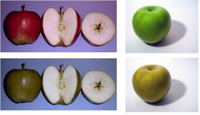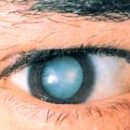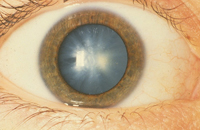Dongtoniki - People who have their own color perception. It does not mean that they see well, they just see a little different than the rest.
Content
Acquired Daltonism may occur only on the eye where the retina or optic nerve is amazed. It has a progressive deterioration over time and difficulties in distinguishing blue and yellow colors.
Less Daltonism is more common, struck both eyes and does not deteriorate over time. This range of daltonism in varying degrees of severity is present in 8% of men and 0.4% of women.
Less Daltonism is associated with the X-chromosome and almost always transmitted from the mother - the carrier of the gene to the son.
 In the central part of the retina, the flower sensitive nervous cells are located, which are called «Columns». They contain three types of flower sensitive pigments of protein origin.
In the central part of the retina, the flower sensitive nervous cells are located, which are called «Columns». They contain three types of flower sensitive pigments of protein origin.
One type of pigment is sensitive to red, the other - to the green, the third - to the blue. More precisely, they are sensitive to the wavelength corresponding to red, green and blue colors in our understanding.
The peak of the daily sensitivity of these pigments (maximum spectral sensitivity of the eye) accounts for a wavelength of 555 nm for red, 530 nm for green and 426 nm for blue.
Vision of all colors of the world is provided «Folding» these three colors in our brain.
People with normal color vision have all three pigment (red, green and blue) and are called trichromates (from the word «chromos» - Colour).
If you distinguish only two colors, you will be called dichroit. This means that one of the pigments does not have in the retina.
Men who have no red pigment are prototopic dichromates, and those who have green pigment - detensopic dichromates (it is customary to call red «Protos» (Grech. - first), and the green color called «deuteros» (Grech. - second), connecting these names of colors with the word «anquia» (absence of vision), formed words «Protandopia» and «Dateranopia» For the designation of color plane on red and green colors).
There are also people who have all three pigments in the columns in stock, but the activity of one of the pigments is reduced. These people - abnormal trichromas.
The red pigment defect in the kolodskok is most often. According to statistics, 8% of white men and 0.4% of white women have a red-green defect color view, three quarters of them - abnormal trichromas.
People with a defect in the blue pigment in Kolzkov are extremely rare, as well as people who have completely absent color vision, t.E. when a person sees well all three colors.
Deviations in color per person do not allow them to say that man is not healthy. It can only be argued that this person has its own color perception of his world, different from other people's color trap.
History taught us many times that all ingenious people perceived the world around them, nature and phenomena are not the case. It is them that we owe new discoveries and inventions.
Color-shaped for one color and people with reduced color vision perceive the paints around them around them differently than we, but often do not notice their differences from others. Do not notice him sometimes and surrounding. After all, these people since childhood learn to call the colors of ordinary items with generally accepted designations. They hear and remember that the grass is green, the sky is blue, blood is red. In addition, they retain the ability to distinguish colors in the degree of lightness.
 Full color blindness is manifested as a family deflection with a type of inheritance and occurs from one person from a million. But in some parts of the world, the frequency of occurrence of hereditary diseases may be more. For example, on a small Danish island, the population of which a long time was led by a closed lifestyle, among 1600 inhabitants were registered 23 patients with full color blindness - the result of a random reproduction of a mutant gene and frequent related marriages.
Full color blindness is manifested as a family deflection with a type of inheritance and occurs from one person from a million. But in some parts of the world, the frequency of occurrence of hereditary diseases may be more. For example, on a small Danish island, the population of which a long time was led by a closed lifestyle, among 1600 inhabitants were registered 23 patients with full color blindness - the result of a random reproduction of a mutant gene and frequent related marriages.
Blind of red and green color is inherited. Because the reason for this or that type of colorplane is molecular defects in the genes responsible for the synthesis of flower sensitive pigments. Currently identified all genes in which pigments are encoded responsible for each of the colors.
To get an answer to the question whether sons can inherit daltonism, a woman should contact a genetic advice. There she will be offered to pass testing.
There are many methods of genetic testing: the study of family history, the study of the color-point in the intended medium of a mutant gene with the help of accurate devices and others. The most modern - methods of genetic testing, allowing to analyze DNA, reveal the mutant gene and clarify the nature of the defect in the protein molecule, which is the cause of eye disease.
If a woman is a carrier of the Gena of Flowerpost and decides not to give birth to a boy, it will be able to conduct ultrasound or genetic testing to determine the sex of the child in the intrauterine period.
And only in cases where the hereditary disease threatens the life of the patient and the hereditary defect is associated with only one genome, it can be resorted to the replacement of a defective protein in the gene. This most perfect method of targeted treatment of color perception defects is still used only under certain diseases.









